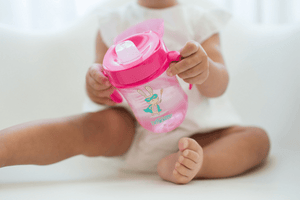
When to Switch from Breast to Bottle, and How to Make It a Gentle Transition
Switching from breastfeeding to bottles is a big step for both you and your baby. It comes with lots of mixed emotions: relief at the thought of mixed feeds and better sleep, worry about how your baby will adapt, and doubt if you’re doing the right thing.
Parents reach this moment at different times, some because they’re returning to work, others due to feeding challenges, or simply because it feels right for their family. Whatever your reason, it’s valid. What matters most is making the shift gently, with care for your baby’s comfort and your peace of mind.
In this guide, we’ll explore how to determine when it’s time to transition, making the change smoothly without disrupting your baby’s feeding rhythm or health.
Why Parents Decide to Switch
There’s no universal moment to transition from breast to bottle. Some parents introduce bottles within the first few weeks to share feeding, while others wait several months once breastfeeding is well established.
Common reasons for making the switch include:
-
Returning to work or needing more flexibility
-
Concerns about milk supply or latch
-
Desire for shared feeding duties between parents or caregivers
-
Introducing expressed milk or formula for convenience
-
Moving toward weaning at the baby’s natural pace
Whatever your reason, remember: this isn’t about replacing comfort but expanding it.
The Australian Breastfeeding Association (ABA) recommends introducing bottles gradually to protect your milk supply if you’re still breastfeeding part-time.
Understanding the Right Timing for Your Baby
Some babies take to bottles right away. Others resist because the texture, temperature, and flow feel different from the breast. That’s perfectly normal; it’s not rejection, just adjustment.
Every baby’s readiness looks different, but a few signs can help you decide when it’s time:
-
Your baby seems easily distracted at the breast or feeds briefly before pulling away.
-
You’re planning a return to work or longer times away from your baby.
-
Your baby accepts a dummy or other oral soothing easily (shows they may adjust well).
-
You want to express and bottle-feed breast milk to maintain flexibility.
Patience is key here. Introducing the bottle slowly gives your baby time to explore, accept, and adapt.
How to Make the Switch Gently
Moving from breast to bottle works best when done gradually. Here’s a step-by-step approach many parents find helpful:
Step 1: Choose the Right Time of Day
Pick a time when your baby is calm and content, not overly hungry or tired. Mid-morning or early afternoon feeds often work best for first introductions.
Step 2: Let Someone Else Offer the Bottle
Babies associate mum with breastfeeding. Sometimes having another caregiver or partner offer the bottle helps your baby accept it more easily, especially in the early days. Learn more from IABLE
Step 3: Use Expressed Milk First
Start with your own milk so the taste and smell are familiar. Once your baby is used to the bottle, you can transition to formula if that’s your goal.
Step 4: Choose a Bottle That Mimics the Breast
Select a bottle with a soft, breast-like nipple and anti-colic venting system, like the Dr Brown’s Options+™ Wide-Neck Bottle. It helps reduce air intake and eases the change in texture and flow.
Step 5: Try a Slow-Flow Nipple
A slower flow mimics the natural pace of breastfeeding and prevents your baby from guzzling too quickly. This keeps the transition smoother and avoids frustration.
Step 6: Keep Close and Maintain Eye Contact
Even with a bottle, babies crave connection. Hold your baby close, skin-to-skin if possible, and maintain eye contact. The same nurturing signals they associate with breastfeeding.
Step 7: Be Patient and Persistent
It might take several attempts before your baby fully accepts the bottle. If they refuse, take a break and try again later. Sometimes changing bottle temperature, nipple shape, or position helps.
Common Transition Challenges (and What Helps)
1. Baby Refuses the Bottle
This happens often in the early days. Try offering when your baby is relaxed but not too hungry, and make the experience gentle and calm. Experiment with different bottle nipple shapes and flows; some babies prefer wide-neck bottles, while others do better with narrow teats.
Dr Brown’s tip: The Options+ range offers both wide and narrow-neck bottles with different nipple shapes and sizes, to help you match your baby’s feeding style.
2. Baby Swallows Too Much Air
A new feeding method disrupts your baby’s established rhythm. This can lead to extra air intake, causing gas or fussiness. To reduce this:
-
Keep the bottle angled so milk fills the nipple tip.
-
Pause halfway through the feed to burp.
-
Use bottles with anti-colic vent systems to limit air bubbles.
This small change often makes a big difference to your baby’s comfort and your peace of mind.
3. Baby Prefers Breast and Rejects Bottle
It’s common for babies to resist bottles at first. Try paced feeding, where you hold the bottle horizontally and mimic the slower rhythm of breastfeeding. It helps your baby stay in control of the flow and feel more familiar with the experience.
Be patient. Transitioning isn’t a one-day process; it’s a series of gentle tries that slowly build comfort and familiarity.
4. You’re Experiencing Emotional Pushback
Many mums describe feeling a mix of sadness and guilt when moving away from breastfeeding. These feelings are real and deserve space.
You’re not giving up — you’re giving yourself and your baby another way to connect. Feeding, whether by breast or bottle, is about closeness, comfort, and care.
If you’re feeling overwhelmed, speak with your GP or a lactation consultant. Support and reassurance make all the difference during this transition.
How to Maintain Bonding During Bottle Feeding
The closeness of breastfeeding doesn’t have to fade when you introduce a bottle. You can keep that same intimacy by:
-
Holding your baby in the same position as you would when nursing
-
Feeding in a quiet, softly lit space
-
Making gentle eye contact
-
Talking softly or humming during feeds
These cues help your baby feel secure, turning every feed — bottle or breast — into a moment of calm connection.
Combining Breast and Bottle Feeding
Many families choose a mixed-feeding approach, combining breastfeeding and bottle feeding. It mostly provides balance and flexibility for you, and familiarity for your baby.
Tips for combining feeding methods:
-
Maintain regular breastfeeding sessions to protect milk supply.
-
Express milk if you skip feeds to stay comfortable.
-
Use bottles that allow a slower, natural flow to avoid preference confusion.
-
Offer the breast when your baby is calm, not overly hungry.
With the right rhythm, you can enjoy the best of both worlds — the emotional bond of breastfeeding and the convenience of bottle feeding.
Choosing the Right Bottle for Transition
Not all bottles are the same, and the right choice can make the transition much smoother. Look for:
-
Soft, breast-shaped nipples for a natural latch
-
Slow-flow options to mimic breastfeeding pace
-
Anti-colic vent systems to reduce gas and fussiness
-
Easy-grip designs for comfort and control
The Dr Brown’s Options+™ range is designed with these features in mind, supporting smooth transitions at every stage, from newborn to toddler.
👉 Explore the full range of Dr Brown’s bottles and feeding accessories at drbrowns.com.au.
Conclusion
Whether you breastfeed, bottle-feed, or do both, the heart of it never changes; it’s about love, nourishment, and bonding.
Shifting from breast to bottle doesn’t remove the bond; it simply opens a new way to share it.
Go gently, trust your instincts, and always keep in touch with your Child Health Professionals.
Remember that you and your baby are finding your rhythm together. With the right tools, support, and patience, every feed can still feel just as warm and connected.
Explore Dr Brown’s Options+™ Bottles and Feeding Essentials — made to make every transition a little calmer, and every feed a little easier.
FAQs
Q1: When is the best age to introduce a bottle to a breastfed baby?
Many parents start between 4–6 weeks, once breastfeeding is well established. Every baby is different, so timing depends on your feeding goals and comfort.
Q2: How do I prevent nipple confusion?
Use a slow-flow nipple and mimic breastfeeding rhythm during bottle feeds. Keep switching between breast and bottle regularly if combining both.
Q3: How long does the transition usually take?
It varies — some babies adapt in a few days, others in a few weeks. The key is consistency, patience, and comfort.
Q4: Can I still breastfeed part-time while bottle-feeding?
Yes. Many mums successfully combine the two. Feed on demand at the breast when possible and offer the bottle for flexibility.







